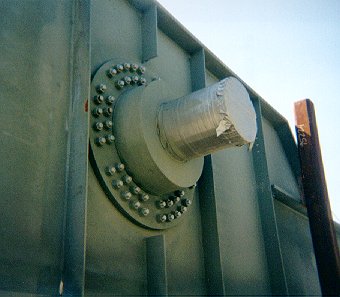DESIGN OF TRUNNION-HUB GIRDER ASSEMBLIES FOR BASCULE BRIDGES
Committed to bringing numerical methods to undergraduates

Home | Grant 1: (98-01) | Grant 2: (01-03) | Grant 3: (04-05) | Pictures | Links
|
DESIGN OF TRUNNION-HUB GIRDER ASSEMBLIES FOR BASCULE BRIDGES Committed to bringing numerical methods to undergraduates |
|
|
|
|
||
|
Home | Grant 1: (98-01) | Grant 2: (01-03) | Grant 3: (04-05) | Pictures | Links |
||
|
Why is this research of Grant 1 being conducted? On May 3rd, 1995, during the process of fitting a trunnion into its main girder of the Christa McAuliffe Bridge, cracks in the trunnion hub were discovered upon the removal of the assembly from the liquid nitrogen bath. This situation generated alarm by all of the parties involved in the project and led to a thorough investigation of the causes and consequences of the problem. The main problem was to find an agreement on how to pursue successful installation of the trunnion hub assemblies, and therefore, continuing with the project. The designer (Bergmann Associates) stood firmly behind their original instructions of installing the trunnion and hubs into the girders as a unit. On the other hand, the suppliers (Sheffield Steel Products) insisted that installing the hubs and trunnions as a unit lent itself to cracking the hub when it was cooled immediately before installing it into the girder. They stated that the only safe way to install the hubs and trunnions was to do it separately. Since the causes of the cracking were not 100% established, it could not be determined with complete certainty, which engineer ws right and which one was wrong. Both sequential and pre-assembled hub and trunnion installations are known to be successful in the past. In February 1998, problems were encountered during the first attempt to install trunnion number 2 into the double girder of the Venetian Causeway Bascule Bridge. Final assembly requires placement of the trunnion assembly into the double girder achieving an FN3 fit at both the Outboard hub to the girder, and the Inboard hub to the trunnion, during the final procedure. The Outboard hub was installed on the double hub trunnion by cooling it in dry ice/alcohol, but after only partial insertion, it was noticed that the trunnion began to stick at the inboard hub. The trunnion was extracted immediately to prevent it from becoming stuck in the girder. It was necessary to review the component materials, the dimensions, and cooling procedures to determine if a sufficient degree of shrinkage can be accomplished in dry ice/alcohol to affect the final assembly double FN3 fit. Also to determine if liquid nitrogen could be safely used to accomplish the fit if dry ice/alcohol were not sufficient. |
| Mechanical Engineering| University of South Florida | FDOT | Contact us |
 |